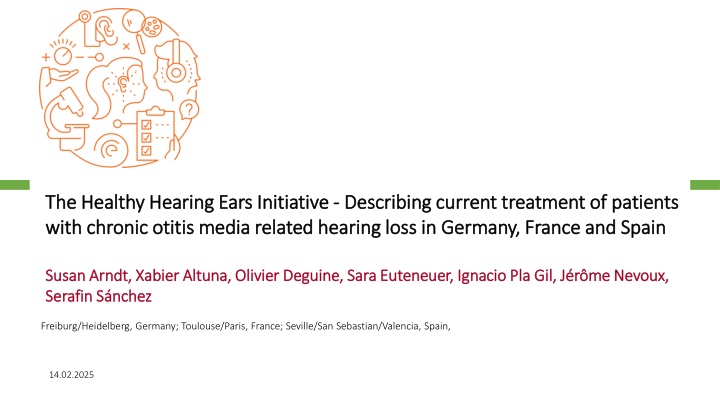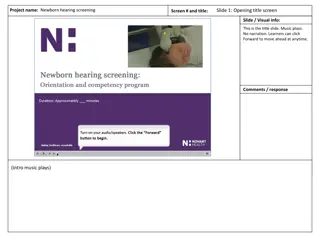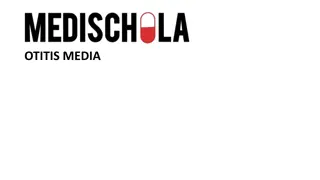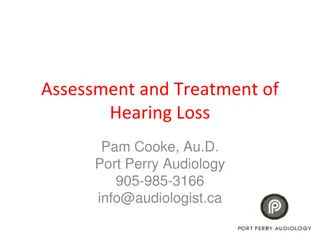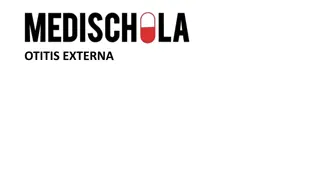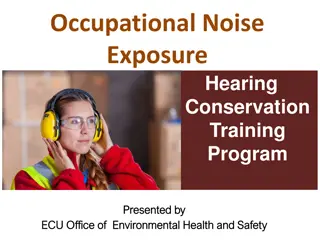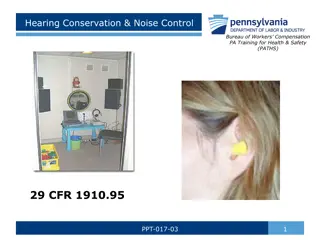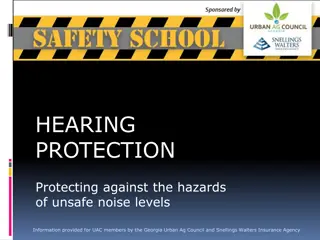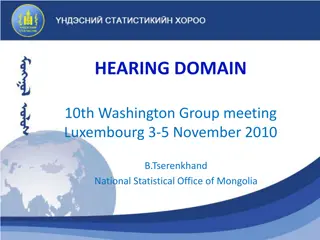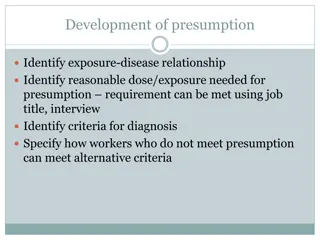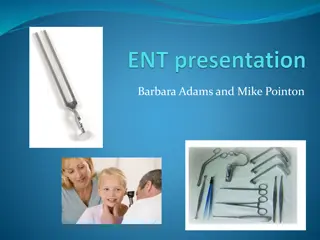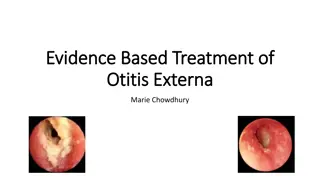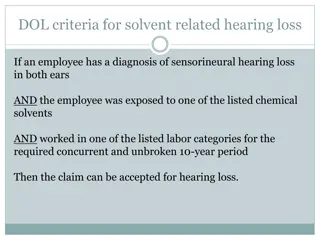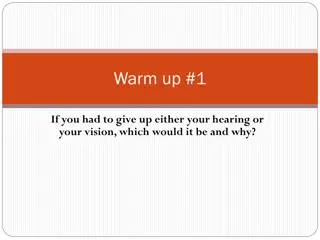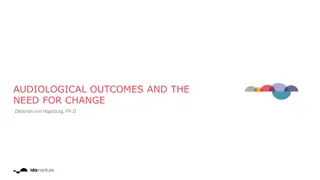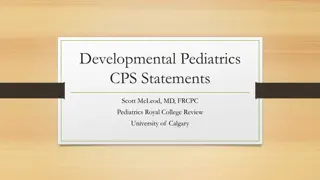Treatment of Chronic Otitis Media Related Hearing Loss in Europe
This study examines the current treatment practices for patients with chronic otitis media related hearing loss in Germany, France, and Spain. The research aims to understand patterns of care, healthcare consumption, and outcomes to guide evidence-based care for improved patient outcomes.
Download Presentation

Please find below an Image/Link to download the presentation.
The content on the website is provided AS IS for your information and personal use only. It may not be sold, licensed, or shared on other websites without obtaining consent from the author.If you encounter any issues during the download, it is possible that the publisher has removed the file from their server.
You are allowed to download the files provided on this website for personal or commercial use, subject to the condition that they are used lawfully. All files are the property of their respective owners.
The content on the website is provided AS IS for your information and personal use only. It may not be sold, licensed, or shared on other websites without obtaining consent from the author.
E N D
Presentation Transcript
The Healthy Hearing Ears Initiative The Healthy Hearing Ears Initiative - - Describing current treatment of patients Describing current treatment of patients with chronic otitis media related hearing loss in Germany, France and Spain with chronic otitis media related hearing loss in Germany, France and Spain Susan Arndt, Xabier Susan Arndt, Xabier Altuna Serafin S nchez Serafin S nchez Altuna, Olivier Deguine, Sara Euteneuer, Ignacio , Olivier Deguine, Sara Euteneuer, Ignacio Pla Pla Gil, J r me Gil, J r me Nevoux Nevoux, , Freiburg/Heidelberg, Germany; Toulouse/Paris, France; Seville/San Sebastian/Valencia, Spain, 14.02.2025
Medical Record Study in Chronic Otitis Media and cholesteatoma Define patterns of care for patients with Chronic Otitis Media (COM), with or without cholesteatoma Understand how current care influence healthcare consumption, hearing outcomes, and health-related quality of life Study aim: Build an improved understanding of current Study aim: Build an improved understanding of current treatment practice to guide evidence treatment practice to guide evidence- -based care and support improved outcomes improved outcomes based care and support
Study setup Site Name Site Name Inclusion criteria Inclusion criteria: Patients that underwent primary tympanoplasty (PT) between 2010 and 2016 with post post surgery surgeryABG 30 dB ABG 30 dB within 12 months after PT Country Country Principal Investigator Principal Investigator N University medical center Freiburg Prof. Susan Arndt (Coordinating Investigator) Germany Germany 14 University medical center Heidelberg Hospital Purpan (Toulouse) Germany Germany Dr. Sara Euteneuer 6 Retrospective study part Retrospective study part Mapping of healthcare utilization (chart review: e.g. demographics, pre-and postoperative audiological assessment, hearing device exposure, medication, examinations, revision surgeries, health care contacts within 6-10 years follow-up) France France Prof. Olivier Deguine 6 France France Hospital Bic tre (Paris) Prof. J r me Nevoux 11 University Virgen Macarena (Seville) University of Donostia (San Sebastian) Spain Spain Dr. Serafin S nchez 3 Spain Spain Dr. XabierAltuna 29 Current study part Current study part audiological status, hearing device use, patient satisfaction (SSQ12/COMOT-15/HUI-3)
Included patients Diagnosis 69 patients 37 women; 32 men Mean age 51 years (18-85 yrs) COM 48% 52% Mean follow up time 7.6 years (5.8-12.3 yrs) COM & Cholesteatoma
Duration of COM and hearing loss Type of hearing loss Mean age at onset of COM: 31.9 years (4-76) Mean duration of COM: 19.3 years (5-72) Mean age at hearing loss onset: 32.5 years (4-75 yrs) Mean duration of hearing loss: 17.5 years (5-70 yrs) Conductive 44% 56% Mixed
Healthcare visits over follow up period Patient type Average no of healthcare visits Average days of inpatient care All patients 9.0 (1-31) 1.8 (0-5) COM 7.6 (1-23) 1.9 (1-5) Cholesteatoma 10.2 (2-31) 1.8 (0-3) Type of visit % Note: Visits to primary care or other speciality centers are not included Heathcare visits for the contralateral ear are not included Audiology 66% Surgery 22% Other 12%
Additional surgeries In total 42 additional surgeries 42 additional surgeries were performed in the ear of the primary tympanoplasty (PT) Surgeries performed Surgeries performed Revision tympanoplasty 22 the average time to the revision surgery was 2.2 years (range 1-3.8 years) Second look 11 Bone conduction implantation 3 Second step tympanoplasty 3 26 patients ( 26 patients (38 38%) %) had additional middle ear surgeries Mastoidectomy 2 Ossiculoplasty 1 14 patients had one one additional surgery 7 patients had two two 3 patients had three three 2 patients had four four
Hearing thresholds pre-op, post-op and at last visit Frequency (Hz) N=69 Median hearing threshold (dB HL) Pre-op Post-op Median ABG 34.1 dB Last visit Median ABG 28.9 dB Median ABG 28.7 dB
Percentage of frequency-dependent change in AC-thresholds Frequency (Hz) Median AC thresholds for patients with: Median hearing threshold (dB HL) Improved hearing, mean 34% 38% No change in hearing, mean 16% 36% 42% 33% 22% 17% More severe hearing loss, mean 48% 16% 14% 20% 12% 49% 42% 41% 43% 65%
Shift in AC hearing thresholds from pre-op to last visit The extent of improved or decreased AC threshold was equal. 25 20 36% 38% 15 42% Mean change in hearing threshold (dB HL) 33% 10 22% 5 0 Hz 250 500 1000 2000 4000 -5 -10 Average AC threshold shift for patients with: -15 42% Improved hearing (>5dB shift) -20 49% 65% 41% 43% More severe hearing loss (> -5 db shift) -25 Improved No change More severe
Average hearing levels at last visit between patient groups Frequency (Hz) No difference in hearing outcomes between patient groups at last visit Hearing threshold (dB HL) All patients COM Cholesteatoma
Amplification of hearing loss Device use at inclusion 49 % used amplification before the primary tympanoplasty 3% 32 Hearing aid No amplification Hearing aid 45% 52% 2 Bone conduction implant (on contralateral ear) BC implant 54 % used amplification at last follow up 30 Hearing aid Device use at end of follow up 7 Bone conduction implant (4 on PT ear and 3 on contralateral) 10% No amplification 46% Hearing aid 44% BC implant
Hearing thresholds by amplification after PT Frequency (Hz) Patients with mixed HL tended to use amplification BC-PTA4 17.5 dB HL vs. BC-PTA4 26.75 dB HL (HA) Median hearing threshold (dB HL) No amplification N=32 Hearing aid N=29 Bone conduction implant N=7
Chronic Otitis Media Outcome Test (COMOT-15) 100 N=68 23 90 Hearing loss is considered main challenge by patients at last follow up 80 27 70 Mean COMOT-15 Score 18 60 Ear symptoms seem to be the least of the problems 20 50 BETTER HRQoL 40 30 20 10 0 Overall Ear Symptoms Hearing Mental status
Summary In the investigated patient group: The likelihood of having improved or decreased hearing outcome was equal over the follow up period nearly 2/3 showed an equal or decreased HL At the last visit patients rated the hearing loss as their main issue in terms of health-related quality of life Need for follow-up of patients after PT with persistent ABG If revision surgery is not successful, an AC-HA or if not possible a bone conduction implant should be considered early Need for increased awareness and information about COM related HL and BCI in case of failed Revision tympanoplasty Preliminary data- outcomes will be analysed more in depth for an upcoming publication of the study
SSQ 12 score-posttherapeutic results N=67 10 possible reflects the unchanged audiometric results 9 2,2 SD 2,2 2,5 8 2,4 7 Mean SSQ Score 6 5 4 BETTER SCORE 3 2 1 0 Overall Speech Spatial Quality
